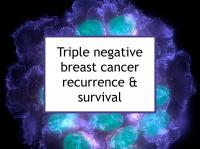Below we summarize data published since 2019 concerning survival of women with early-stage invasive triple negative (ER-/PR-/HER2-) breast cancer. However, please note that outcomes can vary depending on numerous factors and the data represents snapshots from studies that were conducted under a variety of circumstances.
Furthermore, most studies that calculate survival do not present the results as simple percentages. Therefore, the numbers below are somewhat inconsistent and far from complete or definitive and should not be used to calculate your likely recurrence-free survival. However, the statistics are useful in getting a general idea of triple negative breast cancer prognosis and to compare outcomes depending on treatment and other factors.
Definition of recurrence & survival terms
Progression-free survival means that no recurrence, metastasis or breast cancer-related death took place during the specified period. Local recurrence-free survival indicates that no breast cancer was found in the same breast, lymph nodes or chest wall. Distant progression-free survival means there were no distant metastases or breast cancer-related death, however a local recurrence might have occurred. Overall survival means that no death occurred from any cause (including non-breast cancer-specific causes).
Triple negative breast cancer recurrence & survival data
Patient & treatment characteristics → Likelihood of outcome
Triple negative breast cancer with standard treatment
- Standard of care treatment (includes chemotherapy) → 72% to 77% five-year progression-free survival
Degree of pathologic response after neoadjuvant chemotherapy
- Pathologic complete response or minimal residual cancer burden (RCB-I) → 85% to 92% five-year progression-free survival
- Moderate residual cancer burden (RCB-II) → 68% five-year progression-free survival
- Extensive residual cancer burden (RCB-III) → 28% five-year progression-free survival
- Residual Stage II/III disease → 57% five-year distant progression-free survival
Type of surgery
- Early-stage disease. Breast conserving treatment → 87% to 94% five-year distant progression-free survival
- Early-stage disease. Mastectomy → 80% to 85% five-year distant progression-free survival
BRCA mutation status
Lobular breast cancer
- Invasive triple negative lobular carcinoma → 47% five-year progression-free survival
- Non-hispanic black → 79% three-year overall survival
- Non-hispanic white → 83% three-year overall survival
- Hispanic → 86% three-year overall survival
- Asian American → 87% three-year overall survival
Old age at diagnosis
- Age at least 70 → 62% five-year overall survival
- Age at least 70, received chemotherapy (chemo) → 69%-75% five-year overall survival
- Age at least 70, chemo recommended but no chemo → 61% five-year overall survival
- Age at least 70, chemo not recommended, no chemo → 54% five-year overall survival
Late recurrence after early-stage breast cancer diagnosis
- Risk of breast cancer-specific death after having survived 5 years
- ER-/PR- stage T1/T2 N0 → 92% no breast cancer-specific death during years 5-20
- ER-/PR- stage T1/T2 N1 → 88% no breast cancer-specific death during years 5-20
- ER-/PR- stage T1/T2 N2 → 80% no breast cancer-specific death during years 5-20
Below are links to recent studies concerning this topic. Please also see our article on triple negative breast cancer prognosis, which describes factors that drive outcomes in this type of breast cancer.
